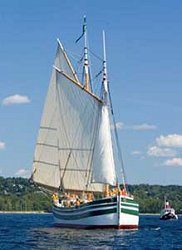- By Bruce Stoff
- Around Town
 Print
Print  Ithaca, N.Y. (June 8, 2007)—Ithaca is the first port of call, July 2-3, for the historic canal schooner Lois McClure on its three-month voyage through New York’s Erie Canal system. The McClure’s Grand Canal Journey will cover 1,000 miles in 100 days, and include stops at 25 ports.
Ithaca, N.Y. (June 8, 2007)—Ithaca is the first port of call, July 2-3, for the historic canal schooner Lois McClure on its three-month voyage through New York’s Erie Canal system. The McClure’s Grand Canal Journey will cover 1,000 miles in 100 days, and include stops at 25 ports.The schooner’s journey is a partnership of the National Park Service Erie Canalway National Heritage Corridor, the New York State Canal Corporation and the Lake Champlain Maritime Museum. The museum owns and operates the Lois McClure as nonprofit educational resource.
To celebrate the McClure’s visit to Ithaca and promote the Cayuga Waterfront Trail, waterfront merchants and community organizations are hosting a two-day schooner festival on Inlet Island, July 2-3. The event offers public tours of the McClure, interpretive presentations of Ithaca’s Erie Canal history, music and informational displays by community organizations. All activities are free and open to the public, with donations accepted to benefit the Waterfront Trail. Hours are 11:00 a.m.– 6:00 p.m. July 2, and 10:00–6:00 July 3. Food and beverages are available from waterfront merchants.
Area boaters can join the schooner as it sails south down Cayuga Lake on the afternoon of July 1, and again the morning of July 4 as the vessel departs on its northbound journey. Spectator vessels are reminded to practice safe boating during the busy holiday period and allow the McClure ample room while navigating area waters.
The schooner Lois McClure is a full-scale replica of an 1862-class sailing canal boat. Constructed in Burlington, Vt. and launched July 3, 2004, Lois McClure is 88 feet in length and 14 feet in beam. Its two masts carry 1,300 square-feet of sail. The original sailing-canal boats were designed to sail from distant lake cities to canal ports using wind power. Upon reaching a canal, the masts were lowered and centerboard raised, transforming the vessel into a typical canal boat.
----
v3i22



